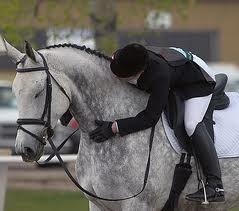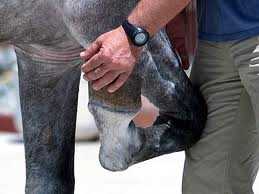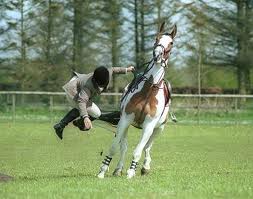|
Owning a horse is a big responsibilitySelecting the Right Horse Selecting the "right" horse can be a monumental task and owning a horse is a big responsibility. Considerations such as safety, use, suitability and housing must be considered. It requires a substantial commitment of both time and money. One of the most important decisions you will make with horses is determining the right horse to use or buy. Safety and suitability of horse to rider are the utmost important factors to consider ensuring a long, enjoyable experience of owning a horse. No horse or pony is always predictable!
Horses are much larger, more powerful and faster than humans. A suitable horse should be appropriate for the person’s level of horse handling skills, and hopefully as safe as possible for its intended use. It is especially important that the novice owner does not get swept away by the color or visual appeal of a horse that may not be suitable for their skills and interests.

Buy or lease? Begin by consulting a knowledgeable horseman to help in finding a horse. Qualified, reputable riding instructors, trainers, breeders, veterinarians or other horse professionals are good sources for help. Next, determine if the horse should be purchased or leased. A lease may be one method to determine if a person is truly committed to the time it takes to care for and work with a horse without owning a Horse. Sometimes a person may even be willing to share a horse vs owning a horse.
A variety of “shared horse” or “shared boarding” options are available to reduce expenses and/or share responsibility for care of the horse with the actual owner of the horse. The conditions of any lease or “sharing” of a horse should be specified in a written agreement.
Where to keep it? Before owning a horse, a suitable place must be found to keep it. Sometimes the initial purchase price is within your price range of owning a horse; however, the cost of routine care including feed, housing, foot care and veterinary expenses must also be addressed. Work out a budget to determine if this venture is truly affordable. Boarding stables often offer a variety of options including full or self-care and the horses may be kept in stalls, outdoor pens, pasture, or dry lots. Cost and the amount of work required will usually vary by option. Some boarding facilities also offer amenities such as exercise, turn out time, etc.
However, these amenities are likely to increase the boarding cost, and must be figured into your budget for owning a horse. Make a list of questions and items to inquire about when looking for a boarding stable. Be certain to take a close look at the condition of the stalls, fences and horses. If you wish to keep a horse on your own property, determine if your property is zoned for owning a horse and physically able to properly and safely maintain a horse. Be certain adequate space and facilities are available for the type of horse you plan to house. There are both benefits and drawbacks to housing your horse on your own place.
Use Once the decision to buy or share a horse has been made, and housing identified, next the purpose and intended use of the horse needs to be determined. Some individuals plan to compete and show whereas others want to trail ride or simply have a horse to ride. A person needs to evaluate what the intended use is in order to determine the breed, age and price range. An outstanding show horse may not be suitable for competitive or pleasure trail riding. Likewise, an excellent trail horse may not be very successful in the show ring. Regardless of intended use, it is best if the first horse is already experienced for your specific use. An older horse that already has the skills needed is usually a better choice for a first-time owner or young rider.
If the first horse experience is enjoyable, you or your child will spend more time with the horse and advance more in your horsemanship skills than if frustrated with owning a horse that is not well suited to your ability. The two or three-year-old horse should be saved for when you or your child are ready for a greater challenge to spur interest.
Locating a horse Locating a suitable first horse can take much time, and patience is very important. Plan to spend considerable time searching and trying out horses, and do not rush into any purchase. Horses for sale can be located in many ways. Local riding instructors or breeders can be very good sources. They usually are familiar with horses in the area and breeders want to make sure their horses are well represented.
Setting the Budget Early in your horse hunting, a budget should be determined and strictly followed. The price of owning a horse must stay within your budget. Compare prices of horses from several sources, review current sale averages of breed auctions, and talk with knowledgeable horse owners, trainers and brokers in your area to establish an idea of reasonable prices.
Try it out No matter how or where a potential horse is located, plan a visit to try it out. Taking a knowledgeable horseman along may be a good idea. Observe the horse as much as you can in various situations such as in the stall, while saddling, around other horses, etc. Close attention should be paid to indicators of its temperament and personality. Watch its eyes, ears, and tail for signs of kindness or irritability. Ask the person selling the horse to do an initial ride so it can be observed.
The horse should be worked to demonstrate its intended use. If the horse is a jumper, it should be worked over fences. A pleasure horse should be ridden in an arena or on a trail, or a reining horse should be worked through the maneuvers of a reining pattern. Next the purchaser should ride the horse them self. Let the owner instruct you to get the horse to perform with the cues it is accustomed to.
Furthermore, a second or third trip may be needed before making the final decision. A more informed buyer will be more willing to make the final purchase and likely will be more satisfied with their purchase after the sale. Additionally, sometimes a brief trial period (7 – 10 days) can be arranged for the prospective buyer.
Horse sales/auctions Novice or first-time horse buyers should avoid horse sales or auctions. Often horses at sales cannot be ridden by perspective buyers, although the seller may demonstrate riding it. Unless a person is very familiar with the horse, its history, and the seller, it is easy to be misled or make poor decisions based on emotion and not knowledge.

Pre-purchase examination A pre-purchase examination by a qualified veterinarian is recommended to help assess the athletic ability, soundness, and conformation of the horse. Conformation and soundness affect the horse’s suitability for a specific purpose and influences its long-term usefulness. The horse should be balanced and sound, with relatively straight legs and free of serious structural abnormalities or health problems. The veterinarian will also examine the teeth, eyes, and general health and help determine its suitability for the intended purpose.
The potential purchaser is responsible for the fees associated with a pre-purchase examination. Furthermore, consult with a veterinarian as to what tests will be conducted. Some additional tests such as radiographs, blood tests, ultrasound, and drug tests may be needed and should be specified.
Get it in writing When a suitable horse is selected, request a sales agreement (or lease agreement). The agreement should define the conditions of the sale, and protect the purchaser in the event of a later dispute. The agreement should identify the horse, the price, deposit – if required, method of payment and any other details, such as a trial period. A bill of sale, transfer of ownership, registration papers and any health certificates should be provided at the time of sale. Some states require brand inspections when horses are sold.
A lease agreement should address issues such as mortality, and who would make the decisions and bear the cost of major medical procedures (e.g. colic surgery). If a trial period is used, the conditions for the trial period should be specified in a written agreement. Written agreements that have been prepared by an attorney that is knowledgeable in the equine industry may also want to be considered.
Get some help Finally, once the horse is found, get a qualified person to help teach how to safely handle, ride, use and care for it. Select a riding instructor or helper who has proper training and experience in working with youth or novice riders. Ongoing instruction and appropriate supervision will help develop horsemanship skills and make owning a horse a rewarding lifelong experience.
Source - Kathy Anderson, Owning a horse
Return from Owning a horse to Horse Riding Connection
|
 A person’s horse handling abilities should be carefully and honestly evaluated before owning a horse . Compare the skill level with the experience, ability and disposition of the horse that is being considered. A green/novice rider is usually not well suited to a young, inexperienced, or highly spirited horse. An older, calmer horse with considerable experience and patience is generally a better match for young or inexperienced riders. Remember “Green plus Green equals Black and Blue”! Recommendations from professionals or knowledgeable horse owners can be very important in locating suitable horses to match one’s ability. An inexperienced rider will likely not have a safe or enjoyable experience owning a horse that is inexperienced.
A person’s horse handling abilities should be carefully and honestly evaluated before owning a horse . Compare the skill level with the experience, ability and disposition of the horse that is being considered. A green/novice rider is usually not well suited to a young, inexperienced, or highly spirited horse. An older, calmer horse with considerable experience and patience is generally a better match for young or inexperienced riders. Remember “Green plus Green equals Black and Blue”! Recommendations from professionals or knowledgeable horse owners can be very important in locating suitable horses to match one’s ability. An inexperienced rider will likely not have a safe or enjoyable experience owning a horse that is inexperienced. 